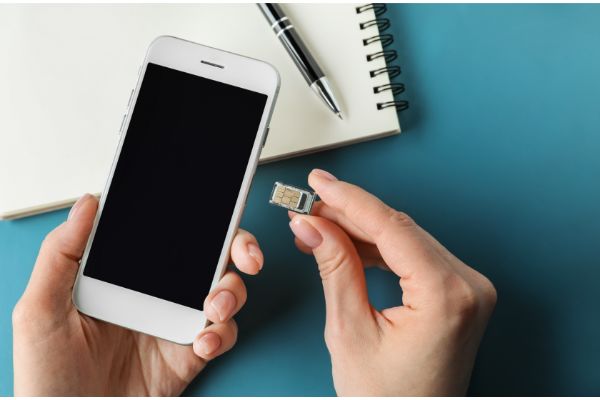Disclaimer: This post may contain affiliate links, meaning we get a small commission if you make a purchase through our links, at no cost to you. For more information, please visit our Disclaimer Page.
Modern smartphones are wonders of technology, and they are not unlike small, powerful computers in our pockets that also happen to make calls the way the landlines of old did. Thanks to how companies and innovators have developed communications technology over the years, millions of people across the world can take their phones with them and still have numbers and signals that are unique to them.
A big part of the reason for this is the SIM card, otherwise something the industry calls the Subscriber Identity Module. A phone’s SIM stores a special serial number that is unique to it, as well as much of the other data that ties your phone number and information as a user to the device that you take with you. Things can get a bit more complex than that, but the SIM card helps your phone make the calls and other things it needs to do, and it keeps the device separate from others around it.
However, certain SIM-free iPhones are available for purchase, too. Some Apple users wonder just what a SIM-free iPhone could be, and how such a device could even benefit them without a SIM installed. We will tackle this very question in today’s article. Further, we can go over some of the benefits and possible challenges that SIM-free phones like this might present to their owners.
To give more details to our readers, we’ll also talk about whether you’re able to put any SIM card in a phone like this, any perceived differences between SIM-free and traditionally unlocked phones, and if it might be possible for Apple users to activate their iPhones without any SIM inside them.
Table of Contents
What Is a SIM-Free iPhone?
Although the short answer is that a SIM-free iPhone does not include a SIM card, there is a bit more to this kind of phone. In order to understand how it is different from the kind with which you may be familiar, we should discuss the contrasts between the two.
Most kinds of phones users get will include SIM cards, and for a good reason. Subscriber Identity Modules (SIM) are a necessary part of what allows you as a user to make calls and send messages using the mobile data that your carrier affords you.
When you purchase an iPhone, you may choose to do it along with the carrier of your choice. Each of the major carriers can have phones with their own SIM cards tied to them inside. In some cases, you may see branding for this carrier right on the phone’s casing, too.
This kind of purchase works best for people who already know which carrier they prefer, or it can make things easier when you are upgrading to a different phone model and would like to keep your existing number and network. In order for all of this to happen, the proper SIM card has to be inside the phone at the time.
However, this kind of phone is not your only option. You can choose to purchase a SIM-free phone. As the name suggests, this device will not include a SIM card in the usual slot.
We touched on it briefly, but this also means that the phone is not yet ready for you to make calls or otherwise use it as a traditional mobile phone at this point. In order to get the full functionality you probably expect from a smartphone, you need a SIM card of some sort.
However, that doesn’t mean that there aren’t some good reasons to buy your iPhone in a SIM-free state, and we can go over some of those aspects in our next section.
What Are the Pros & Cons of a Sim-Free iPhone?
To better understand just how you as a user might benefit from a phone that doesn’t have a SIM card once you get it, we can talk about some of the possibilities of a SIM-free phone.
The points we go over may not be representative of all the potential benefits of phones of this type, but you can get a much clearer idea of how these devices can become popular with others. Of course, we would be remiss if we did not also discuss some of the potential drawbacks of said phones in this section, too.
Pros
1. An iPhone without a SIM card means that you don’t pay for a contract with a carrier outright. This means that you just pay for the handset itself. As we mentioned, you would need to go with some kind of plan or basic contract in order to get the phone to make calls, but it is still an option that can increase your flexibility.
2. Similarly, since you are not paying for a combined phone and contract that the company bundles for you all at once, you can typically get the phone of your choice cheaper than you might otherwise. A flagship or late model might still be a bit expensive, but it should be less so when you are not buying a long-term contract along with it.
3. Although you do need a plan, you can choose the one that has all the features you might want. This leaves you free to go with the network that offers you the perks you enjoy the most. Thanks to this flexibility, you won’t tie yourself to that network or any specific plan. When you get tired of the plan, or if you find a new one, it should be easier to switch things over thanks to your SIM-free phone.
4. If you already have a SIM of your choice that you would like to use, it makes sense to buy a SIM-free phone. Setting it up with the information you already have might be faster and less laborious when you combine the phone with the card you’ve been using for years.
Cons
1. The initial cost that you’ll pay may seem higher than it would otherwise. When you buy a phone from a network, it usually starts with a contract. Because of the contract, you can choose to pay for a newer, more expensive model in installments.
Typically, this is not an option that you will have with SIM-free devices. You’ll need to front the cost of the handset that interests you in its entirety.
2. Although SIM-free phones should offer you quite a bit of variety in terms of what handsets you can choose, some providers have exclusive models or offers. Because you’ve chosen to go without any provider, it is possible that you’ll miss out on some phones you could otherwise purchase. The models in question tend to be niche versions, but this is still something to consider.
3. In addition to some cool phones, network contracts often come with lucrative incentives to get you to sign up for the services. For example, you may get a great deal on talking and texting for the first 12 months of your service plan. Similarly, you might have to pay for a more expensive plan overall in order to keep your phone free of a single network.
Can You Put Any SIM in a SIM-Free iPhone?
No, you can’t necessarily put any SIM card in a phone that the manufacturer lists as SIM-free. There might be some confusion here among consumers who are looking to try the SIM-free option for the first time. At the most basic level, SIM-free is just any iPhone that comes without a SIM card pre-installed in the usual slot.
This does not mean that it won’t take a SIM card, and it doesn’t mean that it will work with any SIM card out there. The main reason for the possible restriction here is that some SIM-free phones might still have ties to one particular network.
While one of the main draws of the SIM-free option is freedom from networks, or more network choices, there are handsets that still go with particular carriers, and this happens regardless of their SIM status. Therefore, it is vital that you check the type of SIM-free phone you are getting.
We touched on it briefly in an earlier section, but a SIM-free phone that a particular network has already locked to itself might still have its uses for some customers. More specifically, if you are a consumer who already has a network of choice and likes it, buying the SIM-free option lets you continue using whatever card you had in your old handset.
What Is the Difference Between Unlocked and SIM-Free?
We’ve spoken at length about how SIM-free phones give you network flexibility. That is true, but SIM-free phones can differ from unlocked ones.
It may be best to illustrate this difference using the pay-as-you-go model of phone plans that you can get. When you are using this kind of payment plan, you still have some choice as to the type of contract or benefits you want to have. Further, you should have more freedom to move to a different kind of plan, particularly as this is not a standard contract.
However, you can still get a SIM-free phone that has network ties that match whatever card you use currently. This is one of the key differences between some types of SIM-free phones and unlocked phones.
Again, many SIM-free phones have no network ties at all, and have never had them at any point. Unlocked phones, on the other hand, usually used to belong to a particular network.
If you bought a phone with a certain network and want to keep it when you move to a new carrier, you may need to unlock it first to allow the device to take the second provider’s SIM. Conversely, if you purchase an unlocked phone outright, you can pair it with the network of your choice. There are only some small differences between a handset that is unlocked and one without a SIM, and they are similar in functionality.
Can I Activate My iPhone Without a SIM Card?
Typically, activating the handset requires the use of a SIM card first. The operating system needs to detect the card in order to complete the whole process. There are ways to use the phone itself without a SIM card, but this avenue relies on you not needing to use it with cellular data in mind.
Further, any time the operating system updates, it will expect a SIM card for reactivation in order for you to keep using the device. In short, you do not necessarily need a SIM to use some features of the smartphone, but you do need one as a way to activate it for the first time.
Conclusion
Flexibility and choice are two important things to many consumers. With so many networks offering some benefits that they then tie to long contracts that may have quite a few disadvantages, it is not hard to see why some people would go for SIM-free phones.
Being able to change networks and plans might be worth the few disadvantages that you may put up with in devices like these. You may pay a bit more for the phone of your choice, but you can also choose the plan that has the perks you want, avoiding many of the trimmings that don’t add any value to how you use the iPhone.


